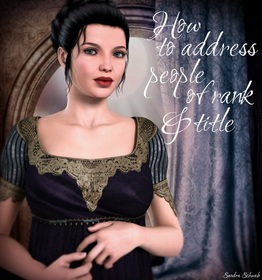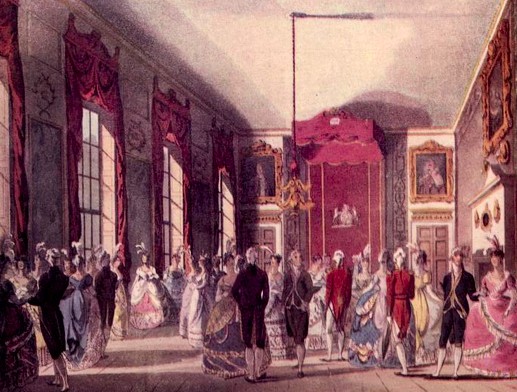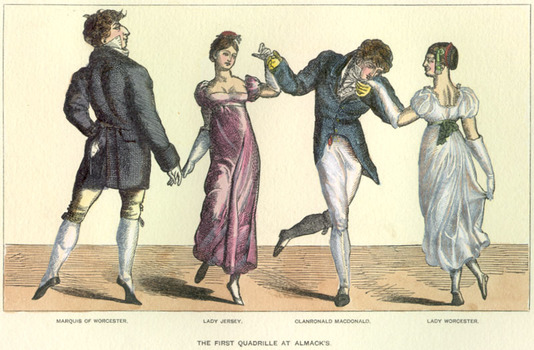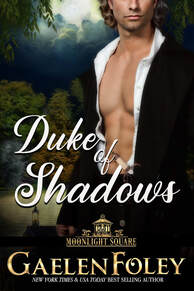|
Imagine you are a Regency miss about to travel to London for your first Season. What's the most important thing you need to know – apart from how to dance gracefully (not the waltz, that dance is terribly improper for young girls!), how to sing prettily, not to traipse around London on your own (*gasp!*), and not to walk or drive down St. James's Street under any circumstances? You need to know how to address all the titled personages you're about to meet, of course! The British were (and still are) a very class-conscious bunch, and not to know the different forms of address possibly resulted in great embarrassment to yourself. So, BE PREPARED! (A most excellent motto for both boy scouts and Regency misses.) The Basics Original art by Sandra Schwab Original art by Sandra Schwab Let's start with some basics: First names were used only among family members and intimate friends, but even for husband and wife, it wasn't too unusual to use the surname or the title when addressing each other. Remember Mr. and Mrs. Bennet in Austen's Pride and Prejudice? They used surnames when talking to each other. However, there's every indication that Lizzie and Mr. Darcy won't follow that example, but will use a much more informal form of address with each other, as was becoming more and more fashionable among young people. Women more readily used first names with each other than men: familiarity among men was typically indicated by using last names (without "Mr."), titles (without "Lord"), or abbreviations of titles (even among family members, abbreviations of titles were often used). Thus, even among the members of the Cavendish family, the son and heir of the 5th Duke of Devonshire was known as "Hart" after his courtesy title of Marquess of Hartington. Indeed, even his own mother, the fêted Georgiana, called him Hart instead of by his Christian name William. And speaking of titles – now, how do you address people of rank and title? (We will assume that our Regency miss meets them only face to face and doesn't write to them – who's got time to write letters in the middle of the London Season anyway?!? – and won't cover the specific rules of how to address people of rank in written correspondence.) Order of Precedence Your place in the pyramid set in stone Your place in the pyramid set in stone Among the peerage, there are five different grades of… hm… aristocratic exaltedness: duke / duchess marquess / marchioness earl / countess viscount / viscountess baron / baroness As most titled people bore (and still bear) more than one title, the heir of a peer (typically the eldest son) would be given one of said peer's lesser titles as a so-called courtesy title. That way, everybody would know to be extra nice to him because he was destined for power and privilege when he inherits. Should you be so lucky as to meet a duke – sadly, they weren't quite as common as our Regency novels might lead you to believe (I've seen estimates of 27 English dukes total in existence during the Regency period) – let's say, William Snorris, who holds the title of Duke of Mulberingham, you would formally address him in conversation as "Your Grace" (if you know him socially, you might even address him as "Duke"). His wife Sarah would also be addressed as "Your Grace" (or "Duchess"). His eldest son bears the courtesy title of Marquess of Snotheringham and would be addressed as Lord Snotheringham and "My Lord". The younger sons of a duke are addressed as "Lord + first name"; the daughters as "Lady + first name." In conversation, our duke would be referred to as either "the Duke" (if there was no other duke around) or "the Duke of Mulberingham." The Marquess of Twillham is referred to as Lord Twillham in conversation and is addressed as "My Lord" (formally) or "Lord Twillham" (socially). His marchioness is addressed as either "My Lady" (formally) or "Lady Twillham" (socially). His eldest son is known by his courtesy title; his younger sons are addressed as "Lord + first name" and his daughters as "Lady + first name." (BTW, if you've seen it also spelled "Marquis" that is the French spelling, which became more common in England during the Victorian era, due to a warming of relations between France and England with the Napoleonic wars a few decades behind them.) John Willingham, who holds the title of Earl of Alwinton, is referred to as Lord Alwinton in conversation and is addressed as "My Lord" (formally) or "Lord Alwinton" (socially). His countess is addressed as either "My Lady" (formally) or "Lady Alwinton" (socially). His eldest son is known by his courtesy title; his younger sons are addressed as Mr. Willingham and his daughter as "Lady + first name." Willam Winsworth, who holds the title of Viscount Crumley (no "of"!!!), is referred to as Lord Crumley in conversation and is addressed as "My Lord" (formally) or "Lord Crumley (socially). His viscountess is Lady Crumley and is addressed as either "My Lady" or "Lady Crumley." All of his sons are addressed as Mr. Winsworth and his daughter as Miss Winsworth. John Green, who holds the title of Baron Snodworth, is always referred to as Lord Snodworth and is addressed as either "My Lord" (formally) or "Lord Snodworth" (socially). His wife is Lady Snodworth and is addressed as either "My Lady" (formally) or "Lady Snodworth) socially. Lord Snodworth's sons are all addressed as Mr. Green and his daughter as "Miss Green." If our Regency miss wants to learn ALL about the members of the peerage before she comes to London, she's well advised to buy a copy of Debrett's, which was and is the who-is-who of the British aristocracy. From Debrett's you can learn all about who married whom, what kind of names they gave to their children, what's their family history, etc. People would often add handwritten notes to entries of peers they were interested in or knew socially. (You can visit their Very Interesting website here: http://www.debretts.com/.)
So what's a Regency miss to do if she's still hopelessly confused by those dratted titles (and we haven't touched upon the members of the gentry and those pesky barons and knights!)? Best perfect your dancing, my dear, so you can at least shine in that regard! :)
1 Comment
10/26/2020 12:46:28 am
The main part.. and the button can you give it some blinking or glowing effect.. On mobile the Text part should come up and then the main video part as seen in the example website.
Reply
Leave a Reply. |
FOLLOW ME ON:
My Latest Release!
Duke of Shadows
A heartbroken belle, a missing suitor, and a heroic duke in disguise. Archives
April 2020
|
Privacy Policy
Cookies Policy
Terms of Service






 RSS Feed
RSS Feed
